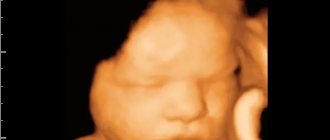Feelings of the expectant mother
During the last trimester of pregnancy you can gain up to 4-5 kg. The abdomen quickly rounds, adding 2-3 cm in circumference per week. Because of the uterus, which occupies almost the entire internal space of the abdominal cavity, displacing other internal organs, you experience shortness of breath, heartburn, and sometimes mild nausea in the morning. To help yourself, eat small portions and don't overeat.
Habitual actions become more difficult: it’s no longer so easy to bend over, put on your shoes, or get out of bed. Don't be shy about asking others for help and be patient.
Due to a shift in the center of gravity, pain occurs in the lower back, and the gait becomes slower, similar to a duck's. We advise you to use a prenatal brace to reduce the strain on your back, especially when standing for long periods of time.
Harbingers of childbirth
In the third trimester of pregnancy, symptoms of impending labor occur:
- Training contractions.
Appear from 35-36 weeks of pregnancy. These are contractions of the uterus when you suddenly experience a nagging pain in the lower abdomen. They have no frequency and go away on their own. To reduce discomfort, try breathing with an extended exhalation or swinging on a fitball.
- Abdominal prolapse.
By the end of the 3rd trimester of pregnancy, the fetus turns head down and gradually moves to the pelvic area. You may feel that breathing has become easier, and heartburn will disappear.
- Removal of the mucus plug.
It can happen all at once just before birth or gradually over the course of a week. This is a light or pinkish jelly-like mass, sometimes with brown streaks, that covered the cervical canal throughout pregnancy. Discharge is often accompanied by discomfort in the lower abdomen.
- Weight loss.
You will notice how you suddenly lost 1-2 kg. This happens by getting rid of excess fluid - the swelling will also disappear. The stool may become loose and lead to diarrhea.
Cold
Even a harmless cold during pregnancy in the 3rd trimester can have a negative impact on the health of the expectant mother, affect the condition of the child and the course of labor. How dangerous is a cold during pregnancy in the 3rd trimester? The degree of danger of a cold increases depending on the intensity and nature of the manifestations, as well as on the duration.
The most dangerous cold is considered to be during the 3rd trimester in the last weeks of pregnancy. If a woman falls ill with an acute respiratory infection in any form during the 3rd trimester of pregnancy, starting from the 36th week, she is urgently hospitalized. This precaution is due to the fact that weakened immunity and gradual aging of the placenta can lead to infection of the amniotic fluid. In addition, a weakened woman’s body may not cope well with labor. It is also worth paying attention to the symptoms of a cold during pregnancy in the 3rd trimester:
- A cough is not just an unpleasant, but a very dangerous companion to a cold. This is especially true for dry, unproductive and deep chest cough. These types of coughs have a spasmodic effect on the abdominal muscles; frequent contraction of the uterine muscles leads to tone and can ultimately cause premature labor. How to treat cough during pregnancy in the 3rd trimester? The safest methods of treating colds during pregnancy include inhalations with medicinal plants. It is important to remember that inhalations should not be hot; if possible, it is better to use a special Nebulizer device or similar devices for this. The choice of composition for inhalation depends on the type of cough; medicinal herbs, infusions and essential oils are most often used. It is better not to select the composition for inhalation yourself, since even herbs and ethers can cause allergies. It is better to consult your doctor. Cough tablets and syrups in the last stages of pregnancy are used in extreme cases, strictly as prescribed by a doctor.
- A sore throat during pregnancy in the 3rd trimester can appear as one of the symptoms of a cold and as a sore throat. If your throat hurts during pregnancy in the 3rd trimester, it should be treated only after examination and consultation with a therapist. The most acceptable method of treating a throat during pregnancy is gargling with the use of medicinal plants (sage, chamomile, plantain), antiseptic, anti-inflammatory and antibacterial solutions (Miramistin, Chlorhexidine, Chlorophyllipt). As prescribed by a doctor, you can use antiseptics and topical antibiotics in the form of aerosols and sprays. As with a cough, with a sore throat, inhalations provide a good therapeutic effect.
- A runny nose during pregnancy in the 3rd trimester cannot be ignored. The danger of a runny nose is that impaired breathing can make it difficult for the child to get oxygen. Vasoconstrictor drugs are contraindicated throughout pregnancy, so you can use drops based on plant extracts and essential oils such as Pinosol, Aqua Maris sea water, you can rinse your nose with cold boiled water with the addition of sea salt, essential oils of tea tree, fir, thuja, and eucalyptus.
- Fever during pregnancy in the 3rd trimester is a very dangerous condition, as it can provoke placental abruption and premature birth. It is better not to allow body temperature to rise above 37.5 degrees. Reducing body temperature with drugs based on aspirin and analgin is strictly prohibited; among the permitted antipyretics, you can use drugs containing paracetamol (Panadol) and ibuprofen (Nurofen).
Treatment of colds during pregnancy in the 3rd trimester should be carried out under the supervision of a doctor, strictly following all his recommendations. Treatment of colds at all stages of pregnancy should be carried out comprehensively; in addition to relieving painful symptoms, it is necessary to eliminate bacterial inflammation and restore impaired protective functions of the body. The latter task is well accomplished by a diet rich in various vegetables and fruits and taking vitamin complexes for pregnant women. Antibiotics during pregnancy in the 3rd trimester are used in extremely rare cases when the risk of developing complications of the disease is considered higher than the risk of using medications.
Fetal development
The main task of the fetus in the third trimester of pregnancy is active weight gain. If at the beginning of this period he weighs about 900 grams, then by the time he is born he manages to add another 2.5 kg on average, depending on hereditary factors.
If at 27-28 weeks the baby moved freely in the womb, tumbled and turned over, then at about 36 weeks he takes a head-down position, moving less intensely, but very painfully for the mother. If you feel him pushing his legs against your hypochondrium, try stroking your stomach and walking around to persuade your baby to change his body position.
By the 38th week of pregnancy, all organs and systems of the fetus are fully developed to function outside the womb. The baby is considered full term. The bones of the skull remain mobile and will grow together only during the first year of the child’s life. This flexibility is necessary for safe passage through the birth canal. The baby reacts to sounds from the outside and is very dependent on your psychological state. He may announce his anxiety or discomfort with sharp jerks.
Interpretation of third trimester screening results
Ultrasound examination indicators correlate with the patient’s period by week.
So, the values for the 32nd week of pregnancy will differ from the same indicators at the 34th week. Normal parameters for screening at 32 weeks are:
- placenta: thickness from 25.3 to 41.6 mm
- amniotic fluid: from 81 to 278 mm
- maturity of the placenta in degrees: first/second
- cervical dimensions (length): from 30 mm
Fetal skeletal parameters at screening 32-34 weeks of pregnancy:
- biparietal size: from 85 to 89 cm
- weight: from 1790 to 2390 grams - length (height): from 43 to 47 cm
- head circumference: from 309 to 323 mm
- fronto-occipital head size: from 102 to 107 mm
- forearm (length): 46 to 55 mm
- shoulder (length): 55 to 59 mm
- Shin (length): from 52 to 57 mm
- thigh (length): 62 to 66 mm
- abdominal circumference: from 266 to 285 mm
Tests and ultrasound
At the beginning of the third trimester of pregnancy, when you apply for maternity leave and receive an exchange card in your hands, you will have to undergo an extensive list of tests and re-consult with a therapist, as prescribed - with an ophthalmologist and other specialists.
List of studies in the 3rd trimester of pregnancy
- general blood test and biochemistry;
- clotting test;
- blood testing for HIV, AIDS, sexually transmitted infections and hepatitis;
- microflora smear.
As before, before each visit to the gynecologist, you take a general urine test and perform a CTG test to assess the fetal heartbeat.
Ultrasound in the third trimester
Performed at 30-32 weeks together with Doppler ultrasound - examination of the blood vessels of the umbilical cord, uterus and fetus. During an ultrasound, a specialist measures the length of the limbs, circumference of the head and abdomen, approximate weight, height and type of presentation. He is also interested in the amount of amniotic fluid to exclude polyhydramnios or oligohydramnios, and the condition of the placenta. The results largely influence the choice of delivery method and determine the need for early hospitalization of the pregnant woman.
ADVANTAGES OF PREGNANCY MANAGEMENT IN THE PIROGOV CLINIC (St. Petersburg)
- A team of experienced, professional and attentive obstetricians and gynecologists - our doctors have experience working in clinics in Europe and the USA, as well as in various medical institutions and maternity hospitals in St. Petersburg.
- The presence of all the necessary highly specialized doctors of different specializations and our own laboratory in one place - test results quickly and with a guarantee of reliability.
- Extremely positive reviews about pregnancy management in our clinic on independent sites.
- Diagnostics using new generation equipment.
- Online consultations with obstetricians and gynecologists
- The clinic is located in a picturesque part of the city on Bolshoy Prospekt of Vasilyevsky Island (free parking, walking distance from the Vasileostrovskaya metro station)
- Service under VHI policies.
Make an appointment with an obstetrician-gynecologist: 320-70-00 - we are always happy to answer your questions!
Possible complications
To prevent and timely diagnose pathologies of the third trimester of pregnancy, do not miss scheduled visits to the gynecologist.
Unusual discharge
Normally, vaginal secretions should be transparent or light-colored. In the third trimester, their volume naturally increases. However, if the discharge becomes too much, it is transparent and more like liquid, you should immediately consult a doctor. Perhaps we are talking about leakage of amniotic fluid. The condition requires observation in a hospital. Depending on the period, a decision is made to continue the pregnancy or give birth early.
Curdled discharge is a symptom of thrush, which often occurs in the later stages due to a general decrease in immunity. It is important to undergo treatment for candidiasis before birth so that the newborn does not become infected while passing through the birth canal.
Bloody discharge in the third trimester is always a dangerous symptom that requires urgent treatment at the hospital. Its possible causes are placental abruption, premature birth.
Diseases
Due to the heavy load on the body, the immunity of the expectant mother noticeably weakens. Therefore, a woman can easily catch a cold, which will be accompanied by such unpleasant symptoms as headache, cough, runny nose and a general cold.
There is no need to panic, because in the third trimester of pregnancy it is no longer as scary as in the first weeks of bearing a child. However, it is worth noting that you should not buy your own medications yourself. It is better to immediately seek help from a doctor who will prescribe the correct and safe treatment.
However, there are still several rather dangerous situations that the common cold leads to. For example, severe nasal congestion can provoke oxygen starvation at the intrauterine level, and a strong cough can even cause premature birth due to involuntary contractions of the uterus. Therefore, it is better not to delay treatment and consult a specialist.
But what should a pregnant woman do if she is faced with such an unpleasant phenomenon as thrush? According to the doctor, its consequences for the child can be very unpleasant.
“During a natural birth, the baby can become infected with a fungal infection that causes thrush or streptococcus. Therefore, before giving birth, it is necessary to sanitize the vagina - around 28 weeks. After two weeks, the patient is tested.”
Since women in such a delicate condition cannot take potent drugs, patients are prescribed bifidobacteria and lactic acid bacteria. Normal treatment through sanitation, according to him, can only be carried out from 37 weeks.
pixabay.com/
Do's and don'ts
Quite often, swelling occurs in the third trimester of pregnancy. To prevent them and alleviate your condition, eliminate smoked and salty foods, reduce your intake of fats and sugar. These substances retain fluid in the body. On the contrary, you should not reduce the amount of water you drink: this will further provoke swelling. Control weight gain, eat more vegetables and fruits.
If swelling does not subside within 3 days, your blood pressure rises, or your weight increases unexplained, consult your doctor immediately. These are symptoms of gestosis in pregnant women - a condition that is life-threatening for the mother and fetus.
Is it possible to speed up labor?
We recommend that you do not resort to “folk” and sometimes dangerous methods of bringing the long-awaited event closer. Avoid lifting heavy objects, taking castor oil, or taking hot baths as this can cause rapid labor, bleeding, and other complications.
If the baby is in no hurry to be born, then medical stimulation in the maternity hospital is the safest way.
Possible dangers and problems of the third trimester
- In the third trimester, due to the increasing pressure of the uterus on the vessels, dilation of the veins may occur. This leads not only to changes in the appearance of the pregnant woman - enlarged veins are noticeable on the woman’s legs, but it is also accompanied by painful pulsation. Varicose venous plexus in the rectal area is called hemorrhoids. Treatment of these conditions is quite complex, so it is important for pregnant women to ensure proper rest and reduce stress on their legs. To prevent varicose veins on the legs, you can start wearing compression stockings, and in order not to provoke the appearance of hemorrhoids, do not push too hard and fight constipation.
- Premature birth is another danger. The baby’s body is not yet ready to face environmental factors that are still aggressive for it, so it will need medical care. However, it is worth noting that the birth of a baby in the third trimester is not as dangerous as in the second. In order not to provoke early labor, a pregnant woman should be especially careful: avoid excessive physical activity, falls and stress.
- Breech presentation of the fetus. By the end of the third trimester, the fetus is in the position from which it will be born. It is desirable that it be a cephalic presentation, when the baby comes out head first. At 28-33, it is sometimes determined that the baby is positioned head up. In this case, there is no need to panic, because the child still has the opportunity to take the desired position. This can be helped by performing special exercises that your doctor can suggest.
- Placenta previa. This is the position of the placenta when it is located in the lower segment of the uterus. Often, precisely because of this location, a woman may experience bleeding, since there is a high risk of placental abruption. But towards the end of pregnancy, the placenta may rise, which will be visible on an ultrasound.
- Placental insufficiency and intrauterine growth retardation. FPN occurs due to changes in the functioning of the blood vessels of the placenta, which can lead to premature aging of the placenta. At the same time, a normally developing baby begins to lack oxygen and nutrients, which is why his condition can significantly worsen and developmental delays begin. Therefore, it is important not to skip all examinations prescribed by your doctor. If such problems are detected in a timely manner, pregnant women are prescribed comprehensive treatment, which will have a positive effect on the baby’s health.
- Shortening and softening of the cervix are changes characteristic of approaching labor. Therefore, women who are found to have a short cervix and its softening are sent to hospital, where the necessary measures will be taken. If doctors determine that the cervix is shortened, the pregnant woman needs to completely abandon physical activity, avoid stress and anxiety as much as possible, and also get plenty of rest.
- Delayed labor. Many women worry when the due date approaches, but the baby is not yet ready to be born. You can talk about this with your doctor, and also familiarize yourself with ways that will help bring your cherished moment closer. In such cases, doctors recommend walking more at a fast pace and actively doing exercises. If there is a significant delay in childbirth, doctors have their own methods, thanks to which the time before labor will be significantly reduced.
Nutritional features in the 3rd trimester
When the stomach drops, the heaviness in the stomach and heartburn go away, a woman’s appetite improves, and a desire arises to eat “something harmful and forbidden.” We advise you not to get carried away; additional stress on the liver and pancreas is completely unnecessary now. No, one cake will not harm you and your baby, but you should know when to stop.
Eat as before, in small portions. To get the vitamins and minerals you need, include the following foods in your diet:
- fresh vegetables and fruits, leafy greens;
- fermented milk products and eggs;
- nuts, dried fruits, vegetable oils;
- lean meat and fish;
- oatmeal, brown rice, millet, buckwheat and other grains.
Limit your consumption of potatoes, confectionery and flour products - sources of simple carbohydrates. Avoid alcohol, carbonated drinks, fried and smoked foods.
Meat, fish and eggs must undergo sufficient cooking. Avoid soft-boiled eggs or medium-rare steak. This will protect you from listeriosis, an infection that has serious consequences for the fetus.
3rd trimester: what tests are usually prescribed for a pregnant woman
What does the final ultrasound examination include? The final study performs three tasks: assessment of the fetus - assessment of the readiness of the uterus for childbirth - assessment of the condition of the placenta and amniotic fluid.
Additional procedures - they are prescribed as necessary - are as follows:
- Dopplerography or Doppler ultrasound of the fetus
is carried out in conjunction with ultrasound, if the device is equipped with the necessary sensor, the goal is to examine the blood flow of the baby and female organs. - Cardiography
- checks the heart rate of the fetus and the contractility of the uterus. - Biochemical diagnostics
- the level of hCG, free estriol (allows us to identify pathology during pregnancy or child development), placental lactogen (helps to timely identify placental dysfunction, the presence of serious diseases in a woman or baby) are determined. - Amniotic fluid index
- amniotic fluid. - Ultrasound of the symphysis
- measurement of the symphysis pubis.
Ultrasound can be performed in 3D and 4D formats, which makes it more informative.
Checklist for the third trimester of pregnancy
- Prepare things for the maternity hospital by first finding out what you can and cannot take with you to the medical facility of your choice.
- Attend an open day at the maternity hospital, plan the route to get there, estimating how long the journey will take.
- When traveling far from home, always take a package of documents with you - exchange card, passport, medical insurance, birth certificate.
- To cope with fatigue, sleep at least 8-9 hours at night, and find time and opportunity for afternoon rest during the day.
- Do not forget about feasible physical activity and Kegel exercises, which are the best way to prevent ruptures and postpartum complications.
- Use our contraction counter - a tool that will help you determine whether they are false or true, calculate the interval between them, so that you can go to the hospital on time.
Keep calm and think only about good things. You have come a long way and very soon you will see such an important person for you. We wish you and your child health! For all questions related to pregnancy and preparation for childbirth, you can contact the Women's Medical Center.
Lifestyle
In a conversation with our publication, Dr. Petreikov recommended that women in the last stages of pregnancy spend as much time as possible in the fresh air. He also explained that there are no special exercises that would make life easier for women carrying a child. In addition, the doctor drew attention to dubious methods of softening the vagina, which can be found on the Internet.
“There is gymnastics for pregnant women, which is carried out in every maternity school. There, women are shown the correct breathing technique before and during childbirth, shown comfortable sleeping positions and helped to maintain an active lifestyle without harm to the baby.”
pixabay.com/silviarita











